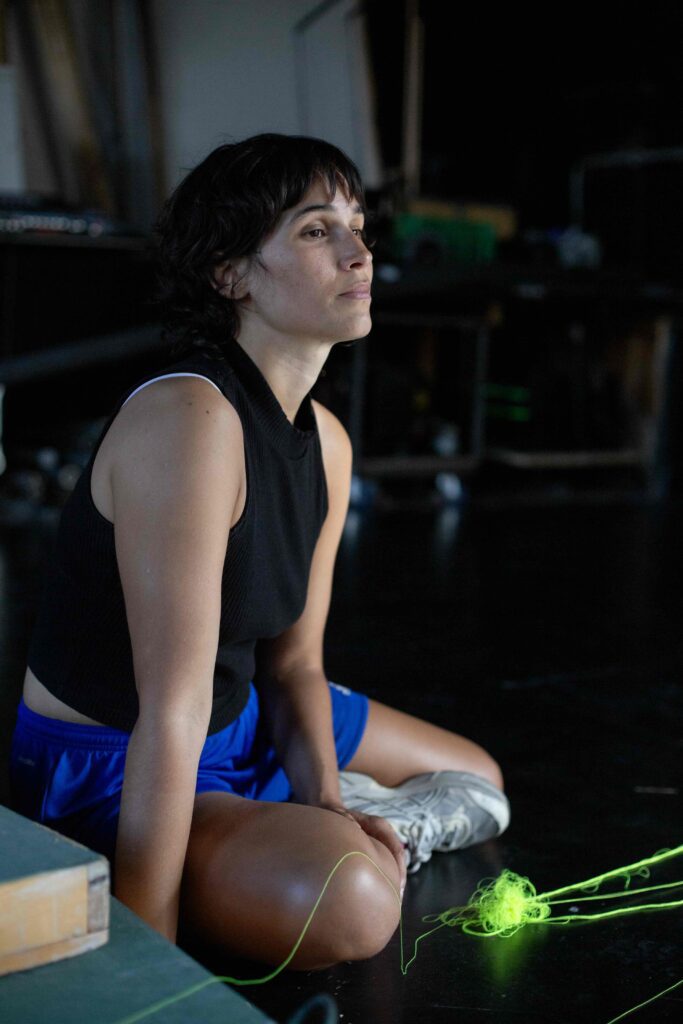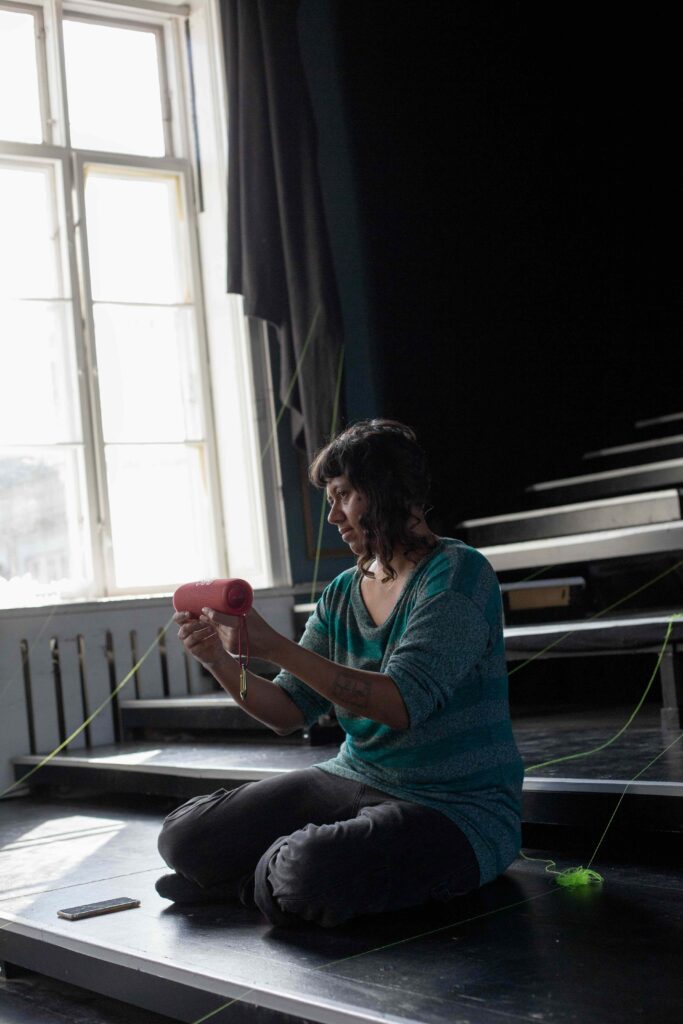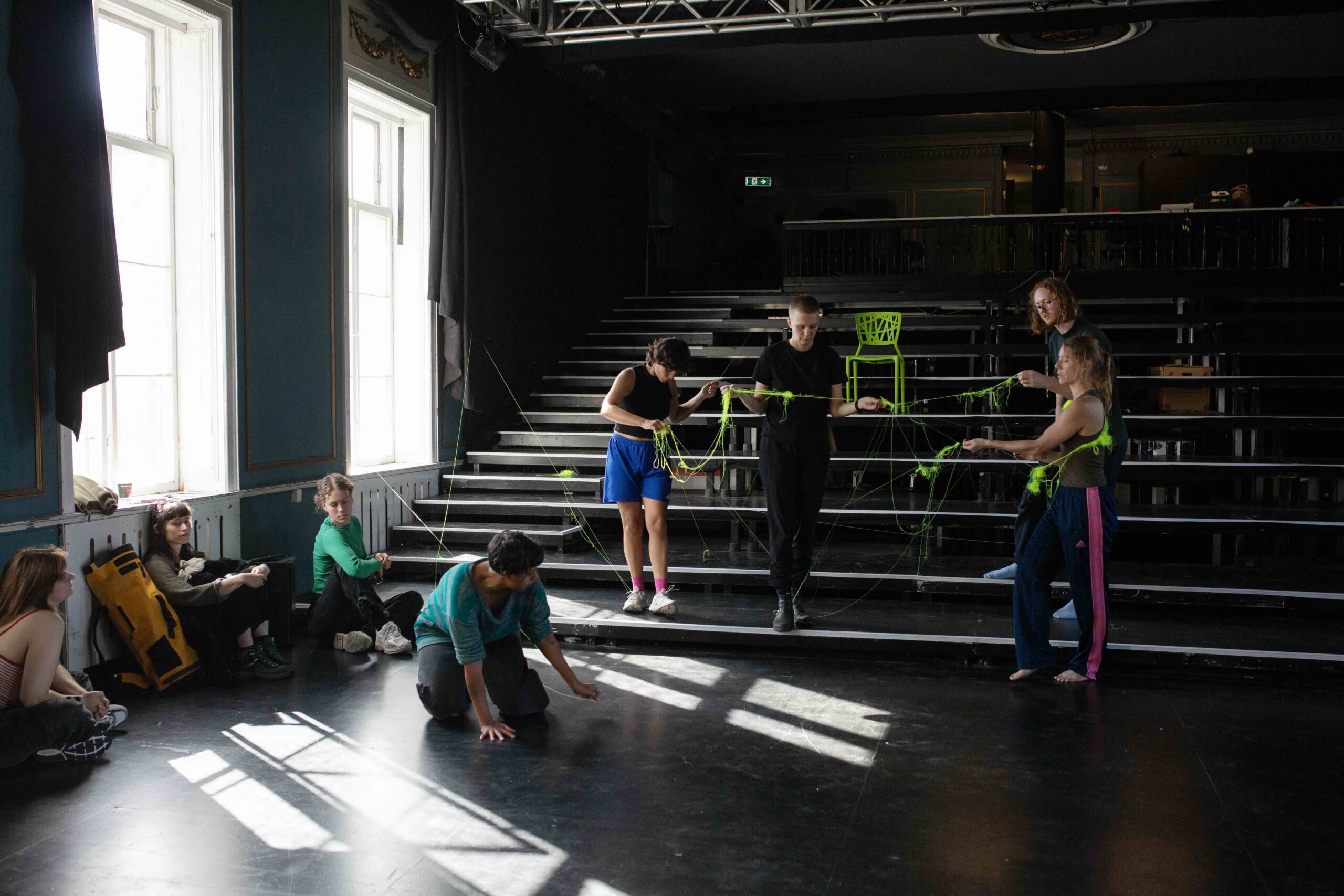This black box has never looked better. The room is completely stripped. The heavy black cloths that once covered the walls and windows are now gone or hanging like dusty curtains along the panels. I had no idea this hall had windows. I’m immediately drawn towards the view, almost forgetting why I’m here.
I’m meeting the artists Marina Dubia, Maria Lepistö, Oriane Paras, PJ Fossum and Sara Vieira Marques during their In Process HAUT-residency named To make move what had been stagnant – disturbing the habits of the black box. Led by Marina they are now working across performance, visual arts, choreography and sound to research how to “connect with the materiality of the black box and its implications to attention and togetherness”. They previously expressed an interest in intimacy and improvisation, sound and voice and “a desire to explore modes of relations between guest and artist”.
Generously they let me observe them twice before their public worksharing. And now, my pen is out of ink and my notebook almost filled.

I want to continue this letter
At the worksharing the audience was asked to write notes or letters about what we experienced. I want to continue this letter:
I was guided, somehow moved by you or the building itself through a dreamlike architecture of sound, movement, bodies, words, whisper, noises, and able to be just me and at the same time be connected to others through this special – and strange – place. I felt sorrow and hope, strength and weakness. A ghost? What lives in these walls? Does the black box change its guests and artists? And why do I feel so much calmer here in this light hall? An exercise in listening and how my attention is pulled in, out, just as you keep pulling the thread, pushing us – recalling former sounds – putting wordlessness into sound.
“Memory is foggy”, you wrote to me in an email. I want to continue the handwritten letter about your sharing but extended to what you shared earlier when you allowed me to spend time in your workspace.

I remember your initial warmups. You did some stretches with eyes closed, and with my eyes wide open I was suddenly watching you without you being able to see me. It felt like cheating, I closed my eyes too, but when I dared to look, it was so pure and beautiful.
I look at you. You seem connected, even with your eyes closed, and I notice the surroundings; plastic hanging in the window; everything is dusty, textiles equal dust; light dust on the black floor. One panel is open, and you can look into the wall. The stage has been removed and the remains piled along the back wall. Backstage becomes one with the rest of the room. There are no lines or margins surrounding the former backstage, stage or the completely removed rows of chairs. Only leftover props, wires, a chair, a disconnected door. Margins fill the centre.
Eyes closed, you wiggle your toes, the house creaks, you rotate, all the joints of the body, warmer and warmer. I only catch some words – otherwise, you are wordless.
Listening to your sounds, I tried to transcribe them, making the echo of the sounds more physical. When you later pull out the thin lines of sewing threads, I see them as small transcriptions, echoes of sound and movement.
You are listening, sitting side by side. Memories of sound and space, your memories mingle with sounds of the house, sounds outside through the open windows. Listening to your breath, the vibrating sounds in the space and your voice: “You don’t have to visualise the sounds… not bound to any materiality.”
You seem to be in sync in this silence. I notice only the materiality of sound: The buzzing of a fly, church bells, children screaming, while you mention the sound of a voice occupying this space earlier today. You suddenly remember powerful memories of family members calling your name, singing in another language. You try to recall a voice but in vain: To remember how a person looks, but not how they sound. Your dreams are almost always silent.

You pull out the sewing threads, strips and tape and a recorder. You hide the many spools of thread in the theatre hall. The choreography of the threads reads: The person who pulls the thread can move around, the others support through attention and voice. Your voices are like mirrors to each other. You’re grooming. Pulling the sound from the core through your memory. A blue thread is drawn like wind through a passage. A blizzard blows around the house. Resounding, corporeal consonants in my notebook. The blue string is left on the floor as an echo.
The source of your voiced words
Wordless, not speechless. Disordered noise makes me tremble. High-pitched sounds, baby talk, polyphonic babbling, long, deep tones and laughter, then ‘okay, okay’. You practise a choir-like soundscape, an ocean of sound. Seagulls – let them in. You roar, plaintively like howls.
I meet you again in the staircase. You’re reading a poem, a text, a combination of two processes; a writing exercise that each of you did individually, and then the process of highlighting your favourite sentences and collecting your fragments collectively into what has become in your own words: “the source of your voiced words”.
a voice that can keep touching.
Sounds with no words, words out of context, justifying an existence.
pushing together from branches and leaves and branches and leaves.
I reach for your attention
I hold it
I hold it,
And I wonder
Will it break if I drop it?
Will it bounce?
What if we learn to scream just right?
It is about that, I think, here happening.
To speak from this darkness, shaking it, breaking it in fractal pieces.
I like being in this body without a body, Nameless, vague, huge.
Dissolving the edges, blurring and softening
(hum along long ding dong drop plop bounce ounce hold it mold it fold it old it… it it up up up what’s up sup)
Nothing is the most generous gift of all.
You’re singing, tasting and testing the words, responding to each other, and I mostly remember this line: “I reach for your attention”.
An inquiry, a plea?
I still recognize the wordless soundscape of un- and intentionally body sounds and movements, sounds of spit, gasp, itching.
To be the dream of the audience
I begin to feel as if I am being pulled through a dream. Do you know this line by artist Theresa Hak Kyung Cha: “I wish to be the dream of the audience”?
Have I entered your dream as you guide me through the building and even behind the panels?
You’re touching the building, inside out. Connected as tissue, not only do you touch the materials of the room, you transfer your own body to the space.
When I see you again everything is different and just as the last time. You have already started. You stand on the stairs outdoors and draw your concentration into your thin, almost invisible thread. Pulling it slowly from above. The sun falls directly on your face. Something is going on inside the house too. Vocal sounds, humming and hands flapping in a window. Distractions. Then completely clear, round and soft sounds reach us from inside the building. We enter.
The stairwell is filled by the sound of footsteps. Further inside on the stairs we meet you as you pull the thread faster and faster while repeating: “keep touching, touching, together, voicing, pushing, touching, voicing, pushing, together, voicing, pushing, pushing, pushing, voicing, pushing, together…”
We enter the secret space behind the wall and your voice whispers inside: “nameless” – “nameless”. We move carefully through a narrow corridor towards the theatre. The former stage is still torn apart while your words and noise draw us closer.

You guided us so far but now you leave us. Still one of you is here, moving in that part of the hall once inhabited by chairs. And then the voices of others, still you, meet us through hidden speakers everywhere as dull but airlike yet loud sounds of movement. You’re working hard, rubbing and stretching repetitively. I hear you from behind the walls. Like a polyphony of creatures.
This is also an exercise in being an audience, listening, managing our attention, together exploring a new, disordered space. How it moves my body, bodies searching for the right spot to be, and then something else. We’re somehow equally present in this space of intimacy or togetherness. Should I move now that you approach me? You choose to move in this direction. Would you like me to move?
The responsibility of the guests is to follow you through several spots, but then you leave us. Setting us free to move and explore your secrets hidden in the hall. We practise being an audience but participants too in a dream of a show. A show both strange and familiar. Are you looking at me now? We notice each other while keeping track of you. So close, but still far as this hidden text by unknown sources. All I can do is to throw myself into your darkness of disordered language that comes towards me – accidents pushing me into new realities.
Caring a neon green tangled thread in a messy web you all approach us while singing surrounded by noises. Your sound is soothing, relaxing like a baby’s humming. Then you pull a speaker playing a foreign tune. A song, in Portuguese, nostalgic and maybe even slightly sad. I don’t know the words and try to catch the vibe. You move your body to the music and others move as little as possible. We keep entering new spaces, and the ending is yet another opening.
